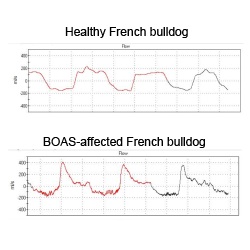Non-invasive respiratory function assessment
We are using whole-body barometric plethysmography (WBBP) to measure respiratory function objectively in brachycephalic dogs.
The test involves placing the dog inside a transparent WBBP chamber with a constant ventilating airflow. The chamber monitors the pressure changes that occur as a result of the dog breathing in and out. A number of respiratory parameters are measured for further data analysis. The dog does not receive any sedatives or general anesthesia. The test takes about 30 minutes and one of the investigators will monitor the entire session. So far over 1800 brachycephalic dogs have been tested and the tolerance rate is approximately 85%.
We have proposed a disease severity index called “BOAS Index (0-100%)”, which is calculated by characterizing respiratory waveforms collected from WBBP. The higher the BOAS Index the more severe the disease. By using the BOAS Index, we are able to monitor disease progression as well as evaluate surgical outcomes. [more details about BOAS Index]
WBBP has been used to assess the effectiveness of laser-assisted turbinectomy (LATE). Our preliminary data show that LATE effectively improved the respiratory function of dogs that did not respond to the primary surgery (i.e. shortening of the soft palate and widening of the nostrils).


Main findings of the study:
- Respiratory flow characteristics are significantly different between brachycephalic breeds and mesaticephalic breeds (e.g. beagles, Labrador retrievers etc.).
- Respiratory flow characteristics are significantly different between pugs, French bulldogs, and bulldogs.
- WBBP is able to differentiate respiratory flow characteristics in BOAS-affected dogs and non-affected dogs.
- Stenotic nares (moderate/severe) and obesity (BCS≥7) are significantly associated with BOAS
→ More information about our research findings...
→ I would like to have my dog(s) tested and participated in the study...
→ I have my dog(s) tested previously and want to know what do those results mean?
